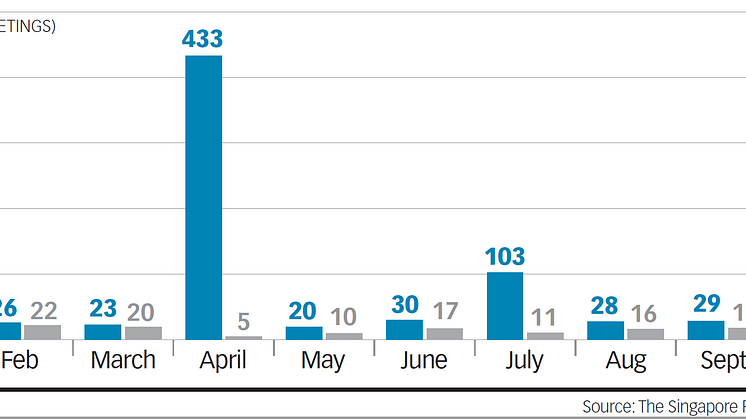
Blog post -
Five things SGX-listed companies must know before holding virtual AGMs
We have had many requests from SGX-listed companies about staging virtual AGMs in our studio due to the COVID-19 disruptions – but there are some pitfalls company secretaries, investor relations officers and communications directors need to know.
Annual General Meetings are held to address burning questions from shareholders, and to vote on resolutions. But due to the COVID-19 outbreak, the Singapore Exchange has granted extensions up to the end of June. Shareholders are unlikely to brave an infectious disease to get answers from boards of directors and the usual buffet spread at the end of the meeting. Depending on the number of shareholders, it would make more sense for companies to hold virtual AGMs to avoid crowded function rooms that could lead to another cluster infection.
Even those companies which prefer to stay with the old-fashioned in-person meetings face a dilemma: directors must be present at AGMs. But what happens if they can't come to Singapore because of the travel restrictions?
VIRTUAL AGMs
A virtual AGM is one that is streamed live to shareholders, and there are good reasons for having one:
- Reach – Share just need holders a laptop or mobile phone with an internet connection to access it.
- Participation – David Gerald, President of the Securities Investors Association (Singapore) said last March a digital approach could also lead to wider shareholder participation. Companies already hold virtual meetings with institutional investors, such as conference calls, and it "would be encouraging" to do this for retail investors as well.
- Cost – Companies do not need to rent a venue, hire a caterer, or engage extra manpower.
- Data – Holding a virtual AGM will allow companies to track the success of the event, as the company can get from the streaming provider data on audience registration, watch times, impressions, participation, drop-offs, etc
- Environment – Shareholders don’t need to travel to a physical venue.
All these make for a compelling case of making your next AGM a virtual one. But before you think about jumping in, there are four things you must know.
- Do your Articles of Association allow it? –Most articles require that the notice of an AGM states the place of the meeting, and some even specify that the AGM must be held in Singapore. This means AGMs have to be held in a physical place. If that is not the case, they would need to apply to shareholders to hold their AGMs virtually. LSE-listed Jimmy Choo has been holding virtual AGMs since 2016. The fashion brand amended its Articles of Association at its 2015 AGM accordingly. Shareholders were invited to participate virtually via an app or online platform and conference call. Your company’s constitution also needs to provide for an adjournment in case the Internet goes down.
- Does the law allow it? – In Singapore, the Practice Guidance of the Code of Corporate Governance, revised on 7 February 2020, says: “Companies should consider other avenues of engaging shareholders, such as through townhall meetings, briefings and roadshows, or webcasting meetings and allowing electronic online voting of shares.” But the Companies Act has not been changed to clarify whether AGMs can be held virtually.
- Quorum – In order for the AGM to proceed a minimum number of shareholders must be present. Most company constitutions would specify the quorum for meetings. Unlike a physical AGM, in which the identity of every attending shareholder can be verified and ticked off on the list in person, it can be tricky for a company to prove that quorum was reached in a virtual AGM.
HYBRID AGMs
A virtual AGM might not be appropriate for all companies and it might be a bridge too far for a company to convince all its shareholders to suddenly switch to a fully virtual format.
Companies which see many shareholders show up to their AGM and who are looking to further increase access to their AGM may wish to consider the hybrid option, in which the AGM is conducted in-room and virtually at the same time. This could be a good option for companies that are listed in a different country from which they are based, as they are able to accommodate interested shareholders in both countries.
Besides geographic considerations, hybrid AGMs can also appeal to two different demographics –younger shareholders are might be more likely to opt for a virtual AGM, and older shareholders who may wish to look directors in the eye in person at a physical AGM.
So, what should you look out for if you are considering a virtual or hybrid AGM?
- Passwords - the platforms we use allow for three types of access: open access where anyone with a link can watch, a common password which is shared by all shareholders who receive an invitation to watch by email, and unique passwords for those shareholders receiving an email invite.
- Technology – Get acquainted with media and technology. The learning curve of employees having to get acquainted with audio, video, camera angles and internet speeds will pay dividends in the long term.
- Voting – There is no guarantee that everyone who watches the webcast is, in fact, a shareholder who is entitled to vote. Encourage your shareholders to complete the proxy vote form so they can still be sure their voices are heard and that votes on resolutions are legally watertight.
- Contingency – There are a few things that can go wrong during a virtual AGM, such as bandwidth speeds falling (hotel ballrooms are notorious for this).
- Communicate the change – Older shareholders who may not be familiar with the technology might need some technical support. Give shareholders more notice than for a regular AGM, and repeat the communication frequently. Explain how you are going to run the event.
DIRECTORS DIALLING IN
There are a variety of platforms available that allow directors to attend virtually, such as Zoom, Skype, Microsoft Teams, and others. But there are more professional platforms out there which give this an entirely polished look and feel.
The experience from the COVID-19 outbreak should prompt companies to prepare for future pandemics, or other disruptions. The technology to allow webcast meetings or vote electronically already exists. We look forward to the necessary changes in the Companies Act and Articles of Association, and a future where virtual AGMs will be the norm.
- Tan Jin San, Hong Bao Media
Related links
- SGX RegCo gives issuers up to 30 June 2020 to hold AGMs to approve FY Dec 2019 results amid 2019-nCoV situation
- Better engagement, but virtual AGMs also come with some risks
- Virtual shareholder meetings – stepping into Jimmy Choo’s shoes or a matter of bad practice?
- MAS Practice Guidance
- SGX RegCo provides guidance on holding of general meetings amid COVID-19
